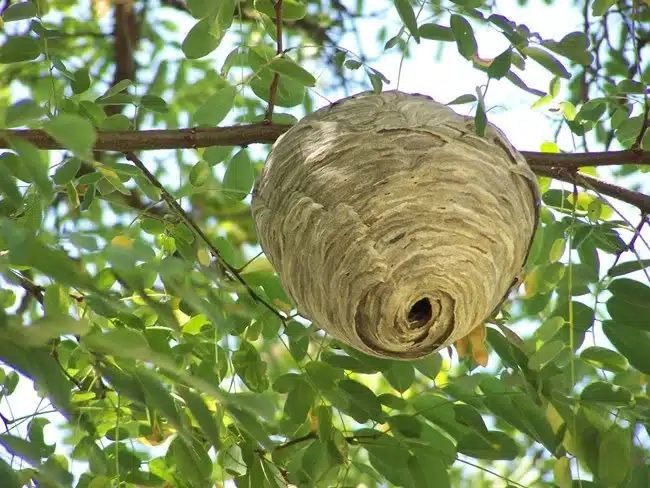When you see buzzing black and yellow insects around your home, it can be tough to tell what type of wasp you’re dealing with. Many people use “wasp” and “yellow jacket” interchangeably, but these stinging insects have important differences. Understanding how to tell a wasp from a yellowjacket can help you decide how to handle them around your property.
Both yellowjackets and paper wasps belong to the same family, but they behave very differently. Some build their nest in the ground, while others hang umbrella-shaped structures under your eaves. The type of nest and the insect’s behavior can tell you a lot about what you’re facing and how aggressive they might be.

What Makes Yellow Jackets Different from Other Wasps
Yellow jackets are actually a type of wasp, but they have some unique traits that set them apart. These social wasps build their nest with a complete paper envelope around multiple tiers of comb. You’ll typically find a yellowjacket nest in the ground, often in abandoned rodent burrows, or sometimes in wall voids and attic spaces.
The eastern yellow jacket is the most common species in our area. These insects are stocky and compact, measuring about 10-15 millimeters long. When they fly, their legs tuck close to their body, making them look more streamlined than other wasp species.
What really makes yellowjackets stand out is their colony size. A mature yellowjacket nest can house anywhere from 1,000 to 5,000 workers by late summer. That’s dramatically more than what you’d find in paper wasp nests, which rarely exceed 100 individuals.
Colony Size Alert
Large yellowjacket colonies mean exponentially higher sting risk. If you see heavy insect traffic in and out of a ground hole, especially during late summer, keep children and pets away and call professionals immediately.
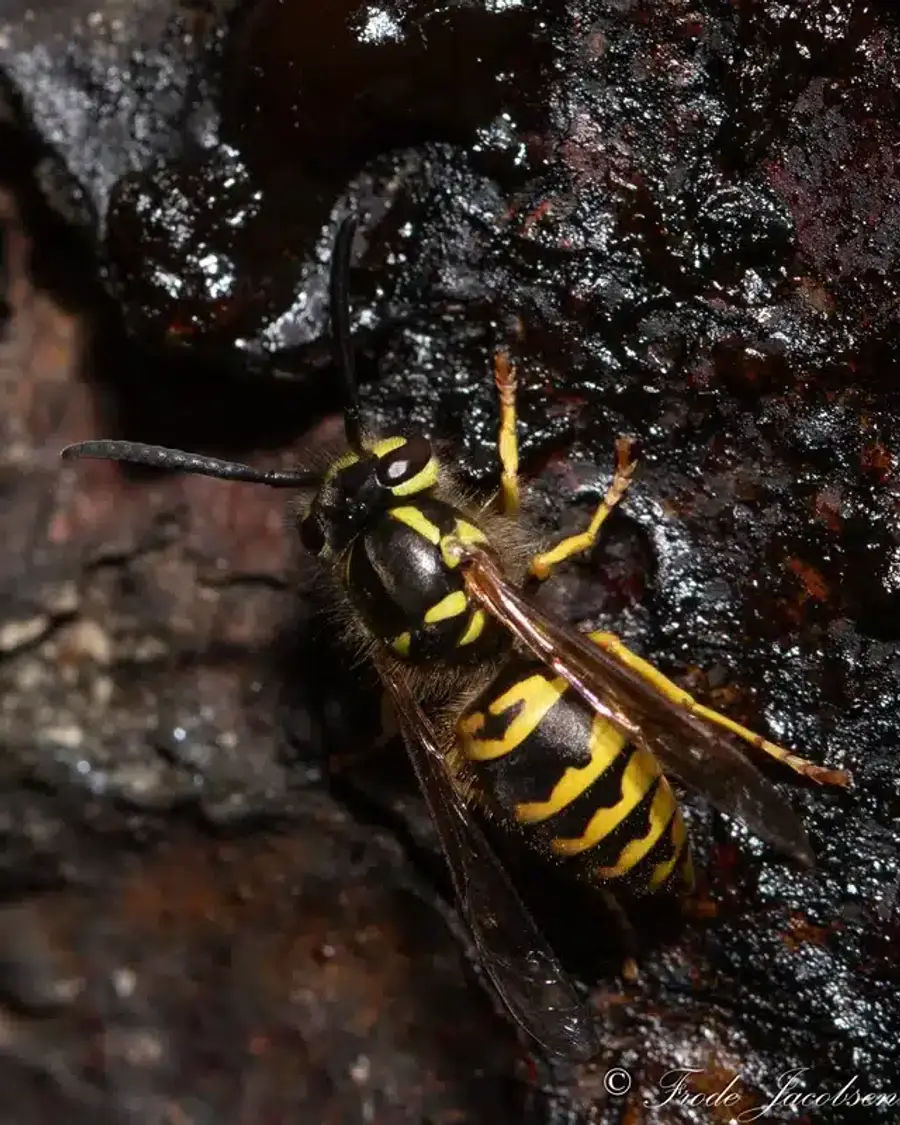
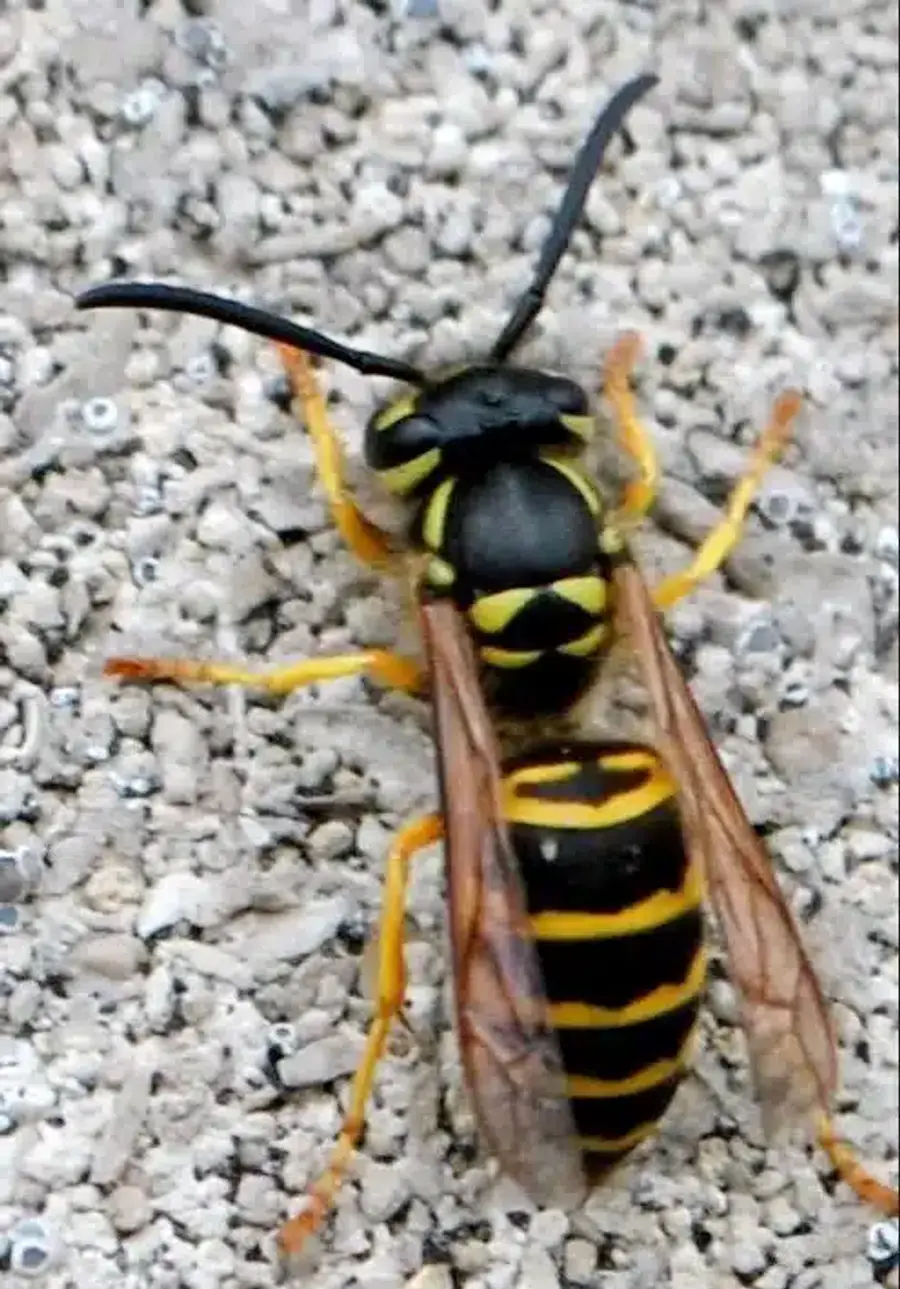
How to Identify Paper Wasps vs Yellow Jackets
The easiest way to tell wasps and yellow jackets apart is by looking at their body shape and nest structure. Paper wasps have a much more slender build with a pronounced “wasp-waist” where their thorax meets their abdomen. They’re also larger, typically measuring 15-22 millimeters.
When paper wasps fly, you’ll notice their legs dangling noticeably below their body. This is completely different from yellowjackets, which keep their legs tucked in tight. The European paper wasp, which is common in our area, also has distinctive orange-tipped antennae that yellowjackets lack.
Color patterns can help too, though they’re not always reliable. Both insects show black and yellow markings, but paper wasps often have more yellow or white on their faces and can show reddish coloration on parts of their body.
Wasp Body Shape and Flight Patterns
Paper wasps are generally more slender than their yellowjacket cousins. Their narrow waist and longer legs make them look more delicate in flight. You’ll often see them flying with their legs trailing behind them, almost like they’re dragging their feet.
Yellowjackets have a more compact, stocky appearance that makes them look tougher and more aggressive. Their smooth flight pattern and tucked-in legs give them a bullet-like appearance when they’re moving quickly.
Yellow Jacket vs Wasp Size Differences
While there’s some overlap, paper wasps tend to be larger insects overall. A typical paper wasp worker is similar in size to a yellowjacket, but paper wasps often appear bigger because of their longer legs and more extended body shape.
| Yellow Jackets | Paper Wasps | |
|---|---|---|
| Body Shape | Stocky and compact | Slender with wasp-waist |
| Colony Size | 1,000-5,000 workers | Under 100 individuals |
| Nest Location | Underground holes | Under eaves, open areas |
| Nest Structure | Fully enclosed | Open umbrella shape |
| Aggression Level | Highly aggressive | Generally docile |
| Flight Pattern | Legs tucked in | Legs dangling |
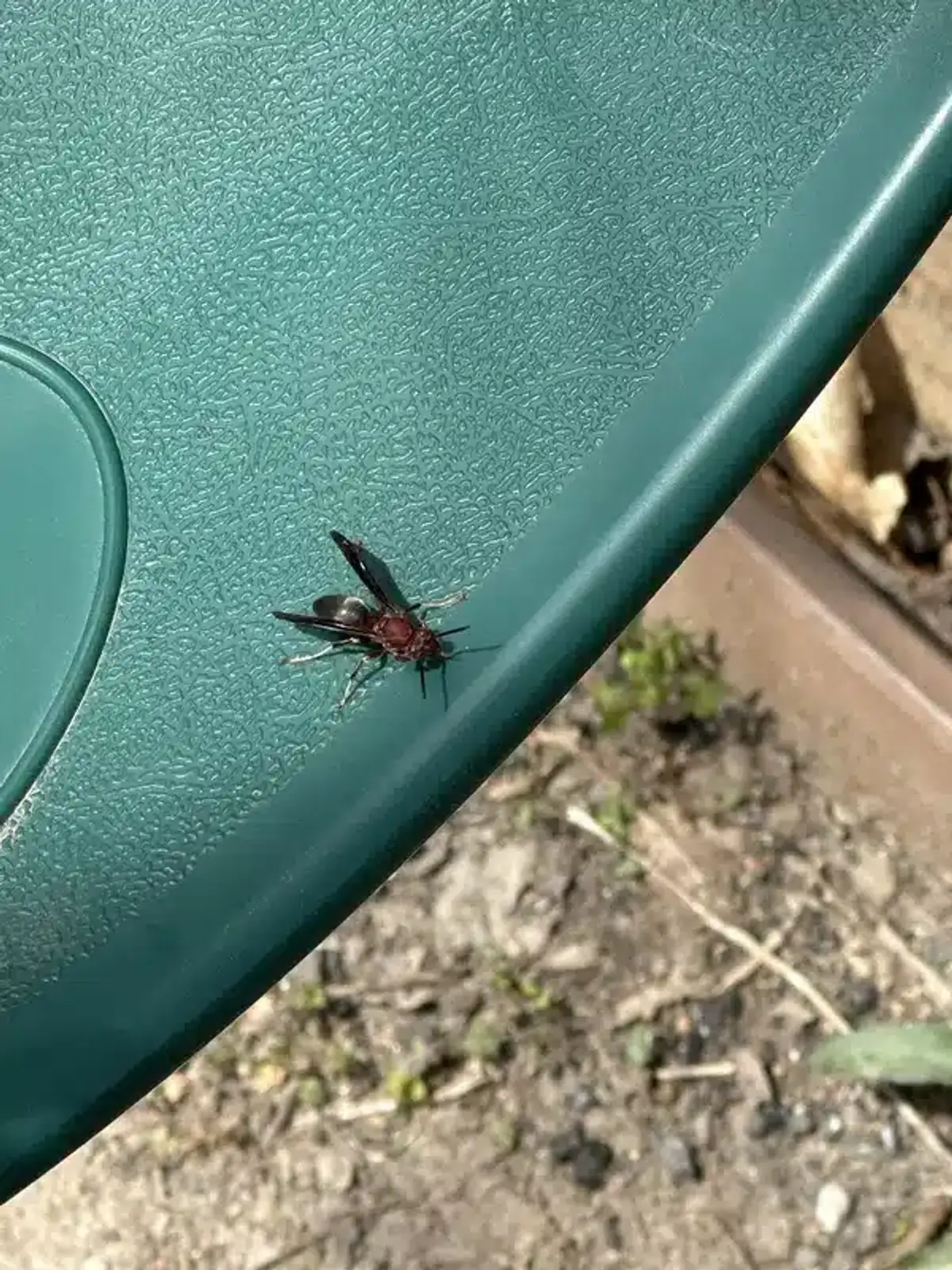
Nest Structures: Underground vs Aerial
The biggest difference between wasps and yellow jackets is where and how they build their nests. This is often the most reliable way to tell what type of stinging insects you’re dealing with around your home.
Yellowjacket nests are built with a complete paper envelope that fully encloses the comb structure inside. You’ll find these nests in underground locations like old rodent burrows, typically within 5 centimeters of the surface but sometimes extending much deeper.
What does the science say?
According to Penn State Extension research, eastern yellowjackets typically establish colonies in pre-existing cavities 6 inches or less below the soil surface. Scientific studies show these underground colonies can expand to house 5,000+ workers by late summer, with some documented cases of nests extending 4-6 feet deep when established in loose soil conditions.
Paper wasp nests look completely different. These insects build their nests as single, open combs that hang from a thin stalk called a pedicel. You can see all the individual cells from below, giving them their characteristic umbrella shape.
Yellow Jacket Nest Locations
Most yellow jacket nests are built in holes in the ground, which is why many people don’t realize they have a problem until they accidentally disturb the nest entrance while mowing or doing yard work. The German yellow jacket, however, prefers to nest in wall voids, attics, or other protected spaces in buildings.
In my experience working with these insects, I’ve found that yellowjacket nest entrance points are usually easy to spot once you know what to look for. You’ll see dozens of workers flying in and out of a single hole throughout the day, especially during late summer when colonies are at their peak size.
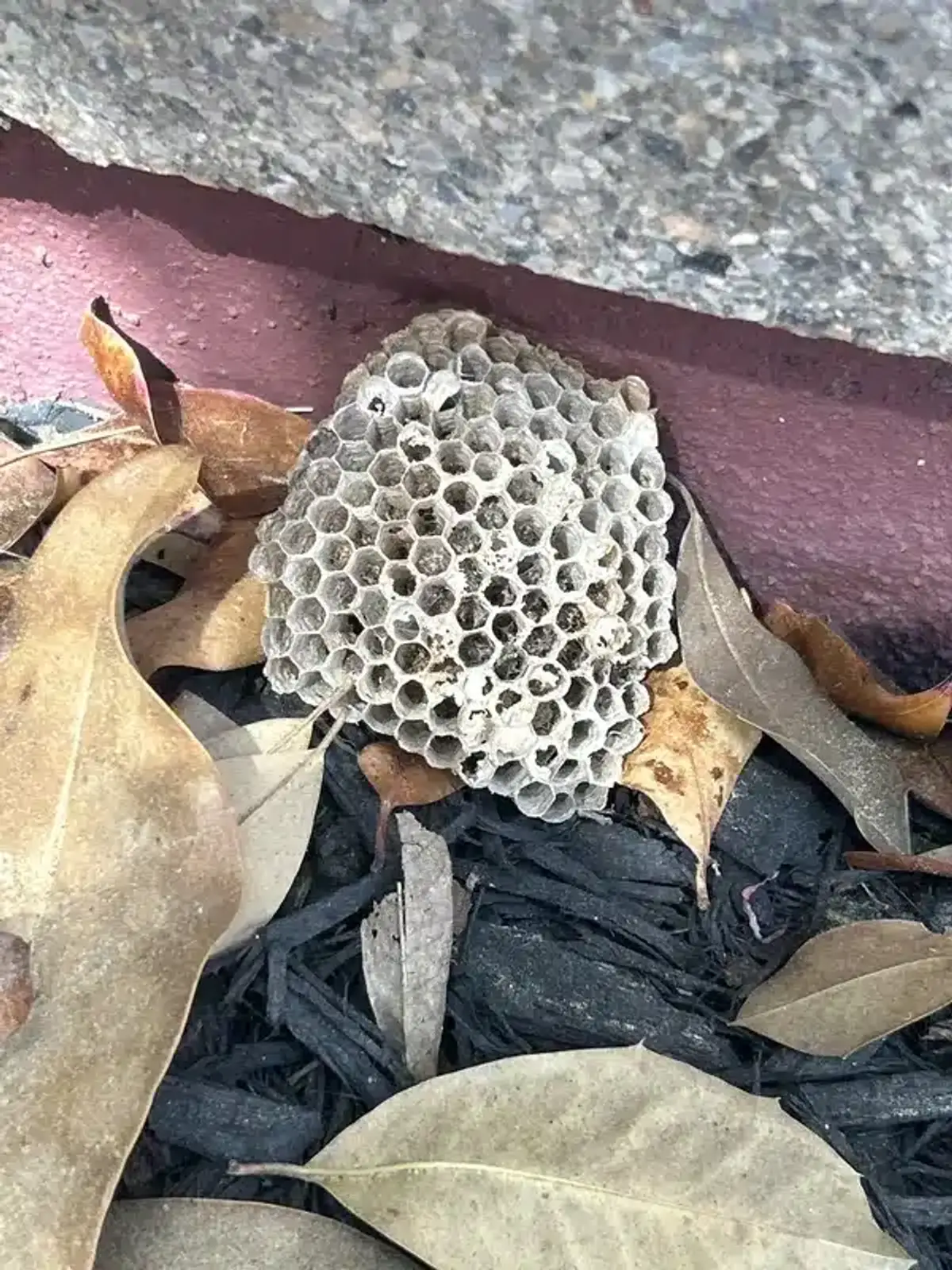
Paper Wasp Nest Sites
Paper wasps prefer to build nests in sheltered areas above ground. You’ll typically find paper wasp nests under eaves, in porch lights, attached to tree branches, or tucked into shrubs. They like spots that offer some protection from rain but still allow easy access for the adult wasps.
These nests are much smaller than what you’d find with social wasps like yellowjackets. Even a mature paper wasp colony rarely exceeds 75-100 individuals, making them far less threatening when the nest is disturbed.
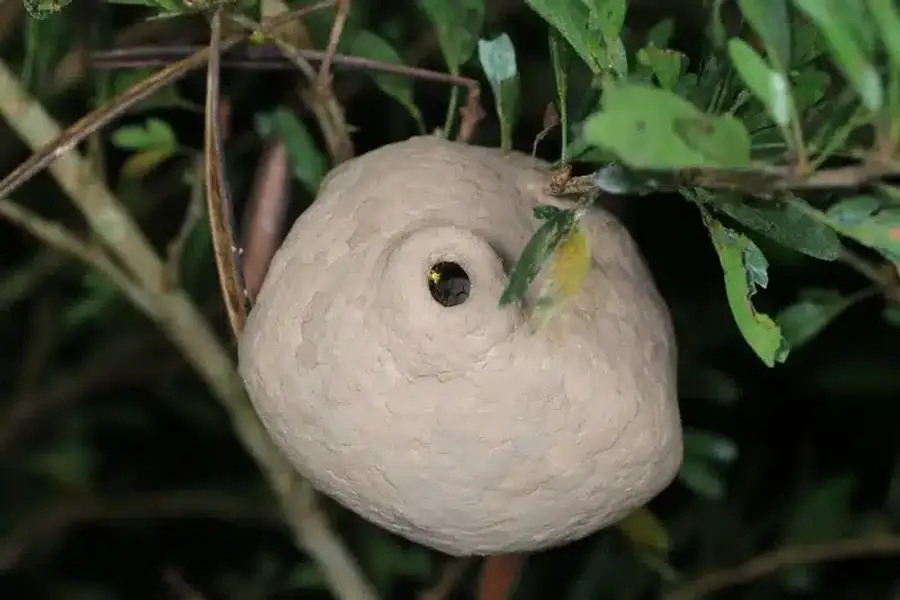

Hornet vs Wasp: Where Do Hornets Fit In?
When people ask about hornets and wasps, they’re often thinking about the bald-faced hornet, which is actually a type of aerial yellowjacket despite its name. These insects build large, football-shaped nests high in trees or on building exteriors.
The European hornet is the only true hornet species common in our area. These insects are much larger than regular wasps or yellowjackets, often reaching over an inch in length. They build paper nests similar to yellowjackets but prefer tree hollows or wall voids for their nest sites.
Hornets are typically less aggressive than yellowjackets but more defensive than paper wasps. Their large size and deep buzzing sound make them intimidating, but they’re actually beneficial insects that help control many pest species around your property.
Seasonal Behavior and When Wasps Become Aggressive
Understanding the yearly cycle of these stinging insects can help you predict when they might become a problem. Both yellow jackets and paper wasps follow similar patterns, but yellowjackets become much more noticeable and aggressive during late summer.
In spring, overwintered queens emerge when soil temperatures reach about 50 degrees Fahrenheit, usually in April or early May in our area. Paper wasp foundresses start their exposed combs, while yellowjacket queens scout for suitable ground cavities or wall voids.
The real problems start in August and continue through September, when yellowjacket colonies reach their peak size. This is when I see the most calls about aggressive wasps around homes and outdoor dining areas.
Spring Wasp Nest Development
Both types of wasps start their colonies the same way - with a single overwintered queen. She builds a small starter nest and raises the first batch of workers. During this early phase, you’re unlikely to have problems with either paper wasps or yellowjackets since there are so few individuals in each colony.
Worker emergence typically happens in late May through June, followed by exponential colony growth during July and August. This is when you’ll start noticing more wasp activity around your home.
Late Summer Stinging Insect Aggression
By late summer, yellowjacket colonies can house thousands of workers, all focused on defending their nest from any perceived threat. The insects also change their diet at this time, switching from protein hunting to seeking out sugary substances like fruit, soda, and other sweet foods.
This dietary shift is why yellowjackets become such a nuisance around outdoor barbecues and picnics during August and September. They’re actively looking for the same foods we enjoy eating outside.

Sting Risk: Which Type of Wasp Is More Dangerous
Both yellowjackets and paper wasps can sting repeatedly since their stingers are smooth rather than barbed like a honey bee. However, the risk level differs significantly between these two types of stinging insects.
Yellowjackets are responsible for the majority of wasp stings and allergic reactions in the United States. According to medical research, yellowjackets account for approximately 62 deaths per year from anaphylactic reactions, with 0.5-4% of the population showing sensitivity to their venom.
What does the science say?
Clinical research published in Medscape Emergency Medicine indicates that yellowjackets and hornets cause the highest number of fatal allergic reactions among stinging insects. Medical data shows that while only 0.5-4% of the population has severe venom sensitivity, yellowjackets’ ability to sting multiple times and recruit nest-mates creates a higher risk of receiving a dangerous venom dose even in non-allergic individuals.
Paper wasps are generally less likely to sting unless you directly threaten their nest or handle them roughly. When they do sting, it’s usually just one or two individuals rather than a coordinated attack by multiple insects.
Yellowjacket Sting Behavior
When a yellowjacket nest is disturbed, workers release alarm pheromones that recruit other colony members to defend the area. This can result in multiple stings from dozens of angry insects, especially if you’re close to the nest entrance.
Case Study: When a Ground Nest Became a Community Threat
Last fall, I responded to an urgent call from a homeowners association about a yellowjacket nest that had residents trapped in their homes. What started as a few complaints about “aggressive bees” quickly escalated into a community-wide safety issue.
- Initial problem: Children couldn’t play in the common area due to aggressive yellowjackets
- Location discovered: Large underground nest in high-traffic walkway between buildings
- Peak activity: Hundreds of workers defending a 4-foot deep colony with multiple entry points
- Treatment approach: Targeted applications at timed intervals over several days
- Follow-up required: Complete excavation to prevent recolonization
Key Takeaway: This case perfectly illustrates why yellowjacket colonies require professional treatment - the sheer number of defensive workers and complex nest structure made DIY approaches impossible and dangerous.
That situation showed how yellowjackets will defend their nest much more vigorously than paper wasps, and how nests in the ground locations can be particularly dangerous since people often stumble onto them accidentally.
Emergency Safety Tip
If you accidentally disturb a yellowjacket nest, don’t swat or run frantically. Move away calmly and quickly in a straight line, cover your face, and seek shelter indoors. Yellowjackets can chase for 50-100 feet when defending their colony.
Paper Wasp Defensive Behavior
Paper wasps are relatively docile compared to yellowjackets. They may sting if you bump their nest or try to swat them, but they rarely launch coordinated attacks. Most paper wasp stings happen when someone accidentally grabs onto them or puts their hand near a nest without looking.
These insects will often give warning signals before stinging, such as flying in an agitated pattern around the threatened area. If you back away from paper wasp nests when you notice this behavior, you can usually avoid getting stung.
Yellow Jacket vs Wasp Diet and Foraging Differences
What these insects eat affects how likely you are to encounter them around your home. Understanding their feeding habits helps explain why yellowjackets become such a problem around outdoor dining areas while paper wasps mostly stay focused on hunting other insects.
Paper wasps are strictly predatory on live, soft-bodied insects like caterpillars and sawfly larvae. Adult wasps also sip nectar from flowers, making them actually beneficial for gardens and landscaping. Some research shows that the European paper wasp can be an effective predator of pest caterpillars.
Yellowjackets start the season hunting insects to feed their developing larvae, but by late summer they switch to seeking carbohydrate sources. This brings them into conflict with humans as they search for sugary foods, fruit, and even carrion around trash areas.
Why Yellow Jackets Invade Picnics
The dietary shift that happens in yellowjacket colonies during late summer explains why these insects become such a nuisance around food. While paper wasps continue hunting caterpillars and other garden pests, yellowjackets are actively seeking out the same sweet drinks and foods that people enjoy outdoors.
This scavenging behavior also means yellowjackets will visit garbage areas and compost bins, potentially spreading bacteria and creating public health concerns that don’t exist with paper wasps.
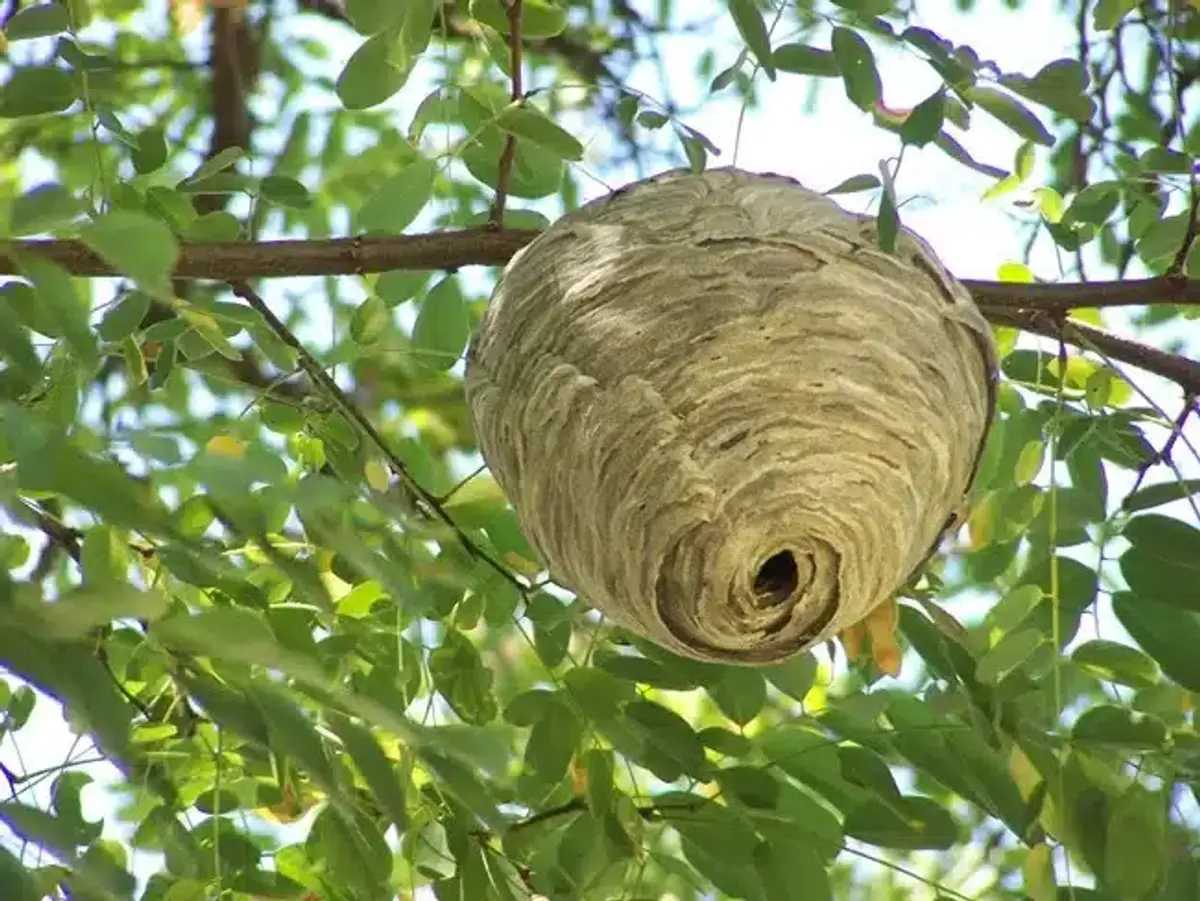
Professional Wasp Nest Removal Considerations
Determining whether you need professional wasp nest removal depends largely on what type of wasp you’re dealing with and where their nest is located. Small paper wasp nests that are away from high-traffic areas can often be tolerated, especially since these insects provide beneficial pest control.
Yellowjacket nests, particularly those in the ground or wall voids, almost always require professional treatment. The large colony size and aggressive defensive behavior make DIY removal extremely risky, especially for people who might be allergic to wasp stings.
In my experience, wasp nests are particularly common in spring when pollinators are most active, as well as at the end of summer in August when they can be most aggressive. Professional pest control technicians always use protective equipment when getting close to these nests because of the sting risk.
It’s worth noting that some wasp nests exist after the wasps have died and can simply be removed carefully with a broom. However, if you’re ever unsure about whether a nest is active, it’s always best to contact a professional pest control company rather than risk getting stung.
When to Call Professionals for Wasp Nest Removal
Any yellowjacket nest should be handled by professionals, especially if it’s located in a wall void or underground near areas where people walk regularly. The potential for multiple stings and serious allergic reactions makes professional treatment the smart choice.
Paper wasp nests may not need immediate removal if they’re in low-traffic areas and the colony is small. However, nests near doorways, play areas, or frequently used outdoor spaces should be professionally treated to prevent accidental stings.
Wasp and Yellow Jacket Prevention and Property Management
Understanding the difference between a yellow jacket and a wasp helps you take the right steps to prevent problems around your home. The approaches for managing these two types of stinging insects are quite different because of their distinct nesting habits and food preferences.
For yellowjacket prevention, focus on eliminating potential nest sites like rodent burrows and wall voids. Keep garbage areas clean and covered, promptly harvest ripe fruit from trees, and seal cracks around your home’s foundation where queens might establish new colonies.
Paper wasp prevention involves removing potential nest sites under eaves, in outdoor light fixtures, and around sheltered areas. Regular inspection of these areas during spring can help you spot new colonies before they become established.
Essential Wasp Prevention Steps
- Early Spring Inspections: Check eaves, outdoor fixtures, and ground areas in March-April before queens establish colonies
- Seal Entry Points: Fill ground holes, seal foundation cracks, and close gaps under eaves where queens might nest
- Remove Food Sources: Keep garbage covered, clean up fallen fruit promptly, and maintain compost bins properly
- Professional Treatment: Never attempt DIY removal of active yellowjacket nests - contact pest control professionals immediately
- Emergency Response: If stung multiple times or showing allergic reactions, seek medical attention right away
Landscaping and Wasp Nest Habitat Modification
Yellowjackets often nest in areas with loose soil and existing cavities. Filling in holes in the ground around your property and maintaining healthy turf can reduce attractive nest sites. Also, keep compost bins covered and clean up fallen fruit to reduce food sources that attract foraging yellowjackets.
Managing paper wasp habitat involves more attention to building maintenance. Seal gaps under eaves, replace outdoor light fixtures that provide convenient nest attachment points, and trim tree branches and shrubs where paper wasps might build their umbrella-shaped nests.
Common Issues When Trying to Tell Wasps Apart
Many homeowners struggle to tell wasps and yellowjackets apart from other similar-looking insects. Bald-faced hornets are often confused with other wasp species, even though they’re actually aerial yellowjackets with black and white coloring instead of yellow markings.
Mud daubers represent another common case of mistaken identity. These solitary wasps build tubular mud nests and almost never sting, but homeowners sometimes mistake them for more aggressive social wasps. Understanding these differences helps you respond appropriately to the insects around your home.
Honey bees are also frequently confused with wasps, especially when they’re swarming or establishing new colonies. However, bees are generally hairy and carry pollen, while wasps have smooth bodies and hunt other insects.
Key Points to Tell a Wasp from Yellow Jackets
The most reliable way to tell what kind of insect you’re dealing with is to observe their nest structure and behavior rather than trying to identify individual insects. Ground-level traffic going in and out of a single hole usually indicates yellowjackets, while visible umbrella-shaped combs under eaves suggest paper wasps.
Body shape in flight is another excellent identifier. Insects with dangling legs are likely paper wasps, while those with tucked-in legs flying in straight lines are probably yellowjackets or other social wasps.
If you’re seeing lots of stinging insects around your property and aren’t sure what type they are, the best approach is to observe them from a distance rather than getting close enough to examine individual markings. Their behavior and nest location will tell you most of what you need to know.
Whether you’re dealing with aggressive yellowjackets or beneficial paper wasps, professional identification and treatment can help keep your family comfortable and prevent serious sting incidents. Our registered technicians have extensive experience with all types of stinging insects common in the DC metro area.
If you’re concerned about wasps or yellow jackets around your home, don’t hesitate to call us at 703-683-2000 for expert identification and treatment options. You can also email us at info@bettertermite.com with questions about the stinging insects you’re seeing on your property.
Frequently Asked Questions
What is the difference between a yellow jacket and a wasp?
+
Yellow jackets are actually a type of wasp, but they have key differences from paper wasps. Yellowjackets are more compact and stocky, build fully enclosed nests often in the ground, and form much larger colonies (1,000-5,000 workers). Paper wasps are more slender with a pronounced waist, build open umbrella-shaped nests under eaves, and have smaller colonies (rarely over 100 individuals). Yellowjackets are also more aggressive and likely to sting multiple times when their nest is threatened.
Is a paper wasp sting worse than a yellow jacket?
+
Paper wasp stings and yellowjacket stings cause similar pain levels, but yellowjacket encounters are generally more dangerous. This is because yellowjackets attack in groups and sting multiple times when defending their nest, while paper wasps typically sting only when directly handled or if you bump their nest. Yellowjackets are also responsible for more allergic reactions and medical emergencies due to their aggressive group defensive behavior.
What kills yellow jackets instantly?
+
Professional pest control treatments using EPA-approved insecticides designed specifically for yellowjackets are the most effective option. These treatments are applied directly to the nest entrance and surrounding area. DIY treatments can be dangerous because disturbing a yellowjacket nest often results in multiple aggressive stings. We recommend contacting professional pest control for any yellowjacket nest removal to ensure your family's protection.
Do yellow jackets sting or bite?
+
Yellow jackets sting rather than bite. They have smooth stingers that allow them to sting repeatedly without losing their stinger, unlike honey bees which have barbed stingers. When a yellowjacket stings, it injects venom through its stinger while also being able to bite with its mandibles, but the sting is what causes pain and potential allergic reactions. Their ability to sting multiple times makes them particularly dangerous when defending their nest.
Where do yellow jackets typically build their nests?
+
Most yellow jacket nests are built in holes in the ground, often in abandoned rodent burrows or natural cavities in the soil. The eastern yellow jacket prefers these underground locations, while German yellow jackets often nest in wall voids, attics, or other protected spaces in buildings. The nest entrance is usually a single hole where you'll see dozens of workers flying in and out, especially during late summer when colonies reach peak size.
Are paper wasps beneficial or harmful?
+
Paper wasps are generally beneficial insects that help control garden pests by hunting caterpillars, sawfly larvae, and other soft-bodied insects that damage plants. They're much less aggressive than yellowjackets and rarely sting unless directly threatened. However, paper wasp nests near doorways, play areas, or frequently used outdoor spaces should be professionally removed to prevent accidental encounters and potential stings.
When are wasps and yellow jackets most aggressive?
+
Both wasps and yellow jackets are most aggressive during late summer, particularly August through September. This is when yellowjacket colonies reach their peak size of thousands of workers and become more defensive of their nest. They also change their diet during this time, seeking out sugary foods and becoming more likely to encounter humans around outdoor dining areas. Early morning and evening hours can also see increased activity levels.
How can I tell if a nest is active or abandoned?
+
Active wasp nests show regular traffic with insects flying in and out throughout the day, especially during warm weather. You'll see workers carrying food back to the nest and defending the area if you get too close. Abandoned nests have no insect activity and often look weathered or damaged. However, some nests may appear inactive during cool weather or early morning hours, so it's best to observe for several hours during warm parts of the day before assuming a nest is abandoned.
With five years of hands-on experience in the pest control industry, George Schulz is a registered technician with the Virginia Pest Management Association and a proud third-generation professional in a family business that's been protecting homes for over 57 years. He manages and trains a team of service pros while also leading internal research efforts—recently spearheading a deep-dive review of thousands of documents on pest control materials to hand-pick the most kid and pet friendly, most effective solutions tailored specifically for homes in the DC metro area.
